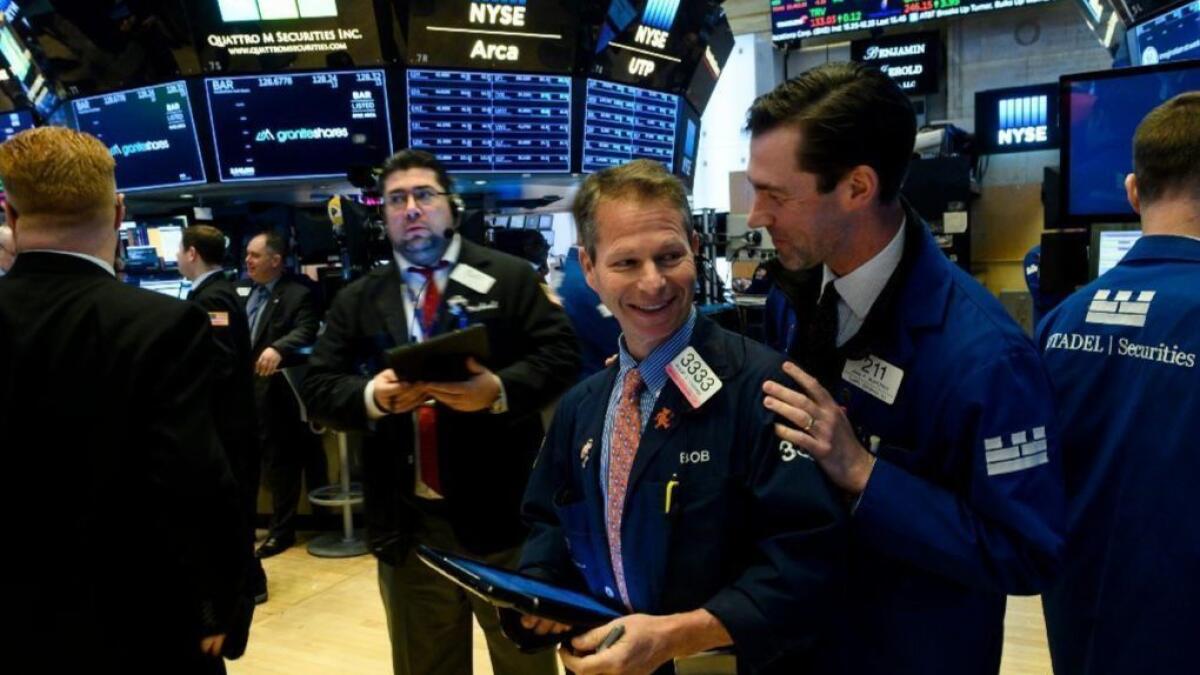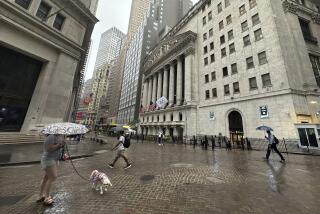This bull market has hit the 10-year mark. Will it keep raging or will bears spoil the party?

In early 2009, a gallon of gas in California averaged $2.16 and the movie “Watchmen” was playing in theaters at an average ticket price of $7.50. “Late Night With Jimmy Fallon” premiered. Facebook Inc. was still a private firm.
On Wall Street, the stock market was mired in a deep slump stemming from the housing and financial crisis then gripping the nation. On March 9 that year, the Standard & Poor’s 500 index closed at 676.53, down a whopping 45% from just six months earlier.
“The numbers are mind-bogglingly awful,” The Times reported the next day, but noted some analysts believed the market was “overdue for a snap-back.”
They were right, and what a snap-back it proved to be, as stock prices then took off in what eventually would become a record long-term rally.
Investors on Saturday will celebrate the 10-year anniversary of the longest bull market on Wall Street since World War II — defined as at least a 20% rise in the benchmark S&P 500 index from its previous low — and the rally has generated a gain of nearly $18 trillion in the index’s market value, according to S&P Dow Jones Indices.
The S&P 500 has more than quadrupled in value during that span as the market repeatedly withstood a barrage of events that threatened to end the bull’s run. The index closed at 2,743.07 on Friday (its eighth drop in the last nine sessions), while the headline-grabbing Dow Jones industrial average closed at 25,450.24, up from 6,547.05 a decade earlier.
Many of those headwinds have occurred in just the last few months, after the market reached record highs. They included the Federal Reserve’s raising of interest rates last fall, the escalating U.S. trade battle with China that lifted tariffs on both sides, fears that the nine-year U.S. economic expansion was about to end and a surge in market volatility, with the Dow swinging by hundreds of points each way in a single session.
All combined to send stocks sharply lower last fall and raised questions about whether the bull finally had run its course. From Oct. 3 to Dec. 24, the S&P 500 at one point plunged 20% on an intraday trading basis and “we definitely had a bear market in my opinion” for a brief period, said Jason Ware, chief investment officer of Albion Financial Group.
But prices rebounded yet again as the market tried to ascend back to its record peaks. And some analysts contend the rally might just set new highs before it’s finally done.
“Despite its old age, we believe the 10-year-old bull market has quite a bit left in its tank,” John Lynch, chief investment strategist at LPL Financial, and Ryan Detrick, the firm’s senior market strategist, wrote in a note to clients Tuesday. “The underlying fundamental backdrop remains quite positive.”
Why has this bull lasted so long? Analysts point to three main reasons: Interest rates have remained low during the last 10 years, inflation has remained subdued and the economy and corporate profits have kept growing.
The Federal Reserve engineered the low-rate setting in good part by purchasing more than $4 trillion in Treasury and mortgage bonds during and after the financial crisis in 2008-09, a move intended to bolster the economy. That move also drove down returns on low-risk assets such as Treasury securities and forced investors searching for higher returns into more risk-bearing assets such as stocks.
“Interest rates, in a sense, started at zero” after the financial crisis “and have taken forever to move higher,” said Sam Stovall, chief investment strategist at CFRA Research.
With the economy growing again, the central bank has been shrinking its bond portfolio and lifting short-term rates. Some analysts suggested those moves have contributed to the market’s recent volatility, such as in December when stocks tumbled and the S&P 500 dropped 9.2% for the month.
There are secondary reasons cited for the bull’s duration as well. No external shock to the markets, such as the 2008-09 financial crisis, has been severe enough to halt the bull market in its tracks. Last year’s tax overhaul led by the Trump administration, which included a cut in corporate tax rates, also helped stimulate more earnings growth.
In addition, the returns on other assets such as Treasury bonds and gold haven’t come close to matching the stock market’s gains, so investors’ cash keeps flowing mostly to equities.
The yield on 10-year Treasurys, for instance, has edged up to only 2.73% from 2.62% a decade ago, resulting in a modest 27% gain over that span, because of the long run of low interest rates and low inflation.
Real estate? The median sales price of a house in Southern California has indeed doubled in the last decade, to about $505,000, but that percentage gain also trails the stock market’s advance.
“Investors are basically saying, ‘I’ve got nowhere else to go,’” Stovall said.
Although this is the longest bull market since World War II, it isn’t the strongest. During the bull market that stretched across the 1990s, the S&P 500 soared 417%, so that indicates this bull market still might have legs.
On at least three occasions, it appeared this bull rally was finished.
In 2011, for instance, the S&P 500 plummeted 19.4% between April 29 and Oct. 3, in response to Standard & Poor’s cutting its credit rating on U.S. debt and heightened concern about the European economy.
Stocks recovered in part because they were led by the widely held big technology shares, such as Facebook, Amazon.com and Netflix Inc., which charged ahead over the next few years and collectively surpassed $2 trillion in market value.
The market also was slammed in 2015 and early 2016 when the Chinese stock market plummeted, sending shock waves throughout the global economy, before rebounding again later in 2016.
And in December, as Wall Street fretted that the Federal Reserve’s interest rate increases and the growing U.S.-China trade battle could slow the U.S. economy, the S&P 500 at one point “fell 20% from prior highs, only to rally by the daily close to narrowly avoid entering a bear market,” Lynch and Detrick noted.
After that, investors again resumed buying when the central bank signaled that it would be less aggressive in lifting short-term interest rates, and at the same time the U.S. economy and corporate profits continued to grow and consumer confidence remained strong. This month, for example, a Wall Street Journal story on employment was headlined “Inside the Hottest Job Market in Half a Century.”
As a result, the Dow Jones industrial average is up 9.1% so far this year and the S&P 500 has gained 9.4%. The tech-heavy Nasdaq composite index has gained 11.7% in 2019.
With all those economic fundamentals still in place, “I see no reason why the bull market cannot continue,” Albion’s Ware said. “We have a strong economy, strong corporate earnings growth, low inflation, low interest rates and an improved investor mood.”
But expect more volatile swings, analysts said.
“We don’t think it will be an easy ride, but we continue to expect eventual new highs,” Lynch and Detrick wrote. “This bull market is indeed alive and well and could make it to 11 next year.”
Others are more cautious, including Josh Brown, chief executive of Ritholtz Wealth Management and author of the popular blog TheReformedBroker.com.
He noted that the S&P 500 not only remains 6% below its record high of 2,930.75 reached Sept. 20, it’s also still below its close of 2,823.81 at the end of January 2018. “We’ve gone nowhere in 13 months,” Brown said.
“If we don’t make a new high above the January 2018 high, and stay above it, there is a school of thought that we’ve already topped out,” he said.
Bull markets typically “don’t end because they get tired,” Brown said. “Usually the reason is people have taken on the maximum amount of leverage and risk because they forget about the bad times,” together with a major event such as the dot-com bust of 2000 or the financial crisis a decade ago, he said. Sometimes the “event” that eventually kills the bull market isn’t even obvious at the time, he said.
And now? Brown never tries to forecast the market’s future, but he added: “If a bear market were already underway right now, I wouldn’t be shocked.”
Twitter: @PeltzLATimes
More to Read
Inside the business of entertainment
The Wide Shot brings you news, analysis and insights on everything from streaming wars to production — and what it all means for the future.
You may occasionally receive promotional content from the Los Angeles Times.











